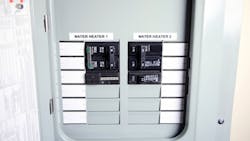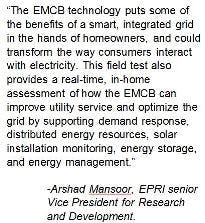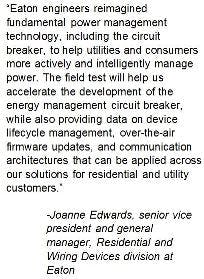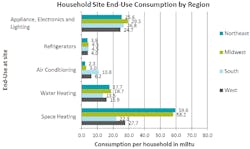EPRI and Eaton Taking Smart Grids and Demand Response to New Levels
More than 500 households at 12 U.S. electric utilities will participate in a project involving a new Eaton circuit breaker designed to improve utility service reliability and optimize the grid.
Under this collaborative demonstration, the Electric Power Research Institute (EPRI) will test and evaluate the impact of Eaton’s energy management circuit breaker (EMCB) in the field.
The data from the testing will be provided to the participating utilities, including American Electric Power, CenterPoint Energy, Dairyland Power Cooperative, Duke Energy, Exelon subsidiaries ComEd and Pepco, Nebraska Public Power District, Seattle City Light, Southern Company, and Tri-State Generation and Transmission Association, Inc.The Eaton circuit breakers also leverage the simple-to-install and maintain Internet of Things connectivity platform from Electric Imp. Eaton collaborated with Electric Imp, co-founded by Hugo Fiennes, to ensure the EMCBs and their managed services are secure, flexible, reliable, and scalable.
Editor’s note: Since a significant portion of demand for electricity in a household involves devices that perform by cycling on and off. The results of the Eaton / EPRI project holds great promise in terms of helping utilities and their customers optimize this coordination of appliance duty cycles, as part of a smart home’s Demand Response capabilities.. For example, a water heater may run only 3 hours in a typical day, and the compressor in a refrigerator may run 80% of the time or less. Similarly, air conditioners, ventilation systems and some other major household appliances, even while being used, do not run at a constant 100% level of their full capacity level.
Even with regional variations and variations in gas vs. electricity usage, the portion of household electricity consumption for appliances which could be addressed by the Eaton circuit breakers is still very large—at minimum 25% to 33% of a typical household’s electric energy consumption—and the potential benefits associated with higher reductions in peak demand are even more significant.
Source: “Opportunities for Home Energy Management Systems (HEMS) in Advancing Residential Energy Efficiency Programs,“ - August 2015 NEEP HEMS Research Report, pg. 47
This is one of the reasons the recent announcement by EPRI and EATON of a collaborative demonstration of a new circuit breaker is so intriguing and important.
The full announcement is available at this link: EPRI, Eaton Commence Field Test of Innovative Circuit Breaker Technology Seeking to Demonstrate More Intelligent, Responsive Grid and Smarter Homes



